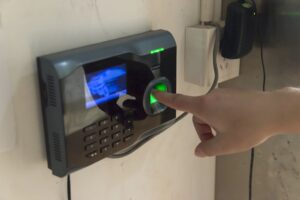Access control solutions for managing building entry
Building security systems are crucial in managing entry and ensuring site security. In today’s world, where security risks are pervasive, it is essential to implement robust access control systems to provide secure access and safeguard sensitive information.
These systems can help restrict entry and grant access to authorized individuals, allowing one person to access via a card or fob at a time. Specialist access control solutions can limit access based on security levels and access needs, effectively maintaining security. These systems provide peace of mind and a higher security level by controlling access through keyless entry and other advanced measures.
Access Control Systems
Access control systems are comprehensive security solutions designed to manage and regulate entry points in buildings. These systems include various components such as access points, entry panels, and electronic access control systems. Access control systems ensure only authorized individuals can enter the premises by granting or restricting access to specific areas.
Access control systems can be categorized into different types based on functionalities and deployment. Some common types include standalone keypad systems, biometric entry systems, and integrated access control platforms. These systems offer powerful access control capabilities, allowing organizations to maintain high security.

Types of Entry Systems
Additionally, existing systems can be upgraded to meet access control needs, protecting the most sensitive areas. Overall, these solutions grant access to authorized personnel and play a crucial role in maintaining a secure environment by restricting entry and managing security risks effectively.
Door Entry Systems
Door entry systems are a fundamental component of access control solutions. They provide a secure and convenient means of entry by utilizing technologies such as key cards, key fobs, or keypad entry codes. Door entry systems can be installed on external doors, internal doors, or gates and barriers, depending on the security requirements of the premises.
Keypad Entry Systems
Keypad entry systems rely on a numeric keypad for access. Users enter a unique code on the keypad to unlock doors or gain entry to specific areas. Keypad systems are widely used in various environments and offer a cost-effective access control solution.
Biometric Entry Systems
Biometric entry systems use individuals’ unique physical or behavioural characteristics to grant access. These systems can incorporate fingerprint scanners, facial recognition, or iris scanners. Biometric entry systems provide a high level of security and eliminate the need for access cards or codes.
Integrated Access Control Solutions
Integrating access control systems with building management systems can provide additional benefits and streamline access management. Integrated solutions allow centralized control and monitoring, making managing access across multiple entry points easier. Organizations can enhance security, streamline operations, and improve efficiency by combining access control platforms with building management systems.
Key Considerations for Access Control System Installation
Before installing an access control system, it is important to consider several factors to ensure its effectiveness and compatibility with the existing infrastructure. Some key considerations include:
Assessing Security Requirements
Evaluate the specific security needs of your premises, such as the number of access points, the level of security required, and the sensitivity of information within the building.
Choosing the Right Access Control Solution
Select an access control system that aligns with your security requirements and provides the desired functionalities. Consider factors such as scalability, integration capabilities, and user-friendly interfaces.
Installation Process and Considerations
Plan the installation process carefully, considering the layout of the building, wiring requirements, and any potential disruptions. Engage professional installers to ensure a smooth and efficient installation.

Enhancing Building Security with Access Control Systems
Implementing access control systems offers several security enhancements for buildings and premises. Some notable benefits include:
Restricting Access to Specific Areas
Access control solutions enable organizations to regulate access to certain areas within a building. Sens-sensitive areas can be safeguarded effectively by granting access only to authorized personnel.
Monitoring and Reporting Capabilities
Access control systems provide robust monitoring and reporting features. They can generate detailed logs and video footage of entry events, helping security personnel identify potential security breaches or suspicious activities.
Preventing Unauthorized Access and Intrusions
Access control systems act as a deterrent for unauthorized individuals attempting to gain entry. With features like key cards or biometric verification, the risk of unauthorized access is significantly reduced.
Access Control Solutions for Various Environments
Modern access control systems integrate physical and digital security measures to streamline access management. They alert security personnel to any intruder or unauthorized attempt to gain entry, enhancing site security. By incorporating commercial door locks and programme-based access levels, these systems ensure that only those authorized to enter can do so. Access control systems find applications in various environments, catering to specific security needs. Here are a few examples:
Access Control in Office Buildings
In office buildings, access control systems regulate entry to different floors, departments, or restricted areas. They provide a secure environment for employees, while also allowing for easy management of access permissions.
Access Control in Commercial Spaces
Commercial spaces such as shopping malls or retail stores often require access control systems to ensure the security of valuable merchandise and protect against theft or vandalism.
Access Control in Residential Complexes
Residential complexes can benefit from access control systems to control entry to common areas, parking lots, or individual units. These systems enhance security and provide peace of mind to residents.
Benefits of Access Control Systems
Implementing access control systems offers several benefits for organizations and premises. Some key advantages include:
Improved Security and Safeguarding Sensitive Information
Access control systems provide an additional layer of security, protecting sensitive information and valuable assets. Organizations can mitigate the risk of unauthorized access by restricting access to authorised personnel.
Convenience and Efficiency in Managing Access
Access control systems streamline the entry process by eliminating the need for physical keys or manual checking. Authorized individuals can quickly and safely access the premises using key cards, fobs, or biometric verification.
Higher Level of Security Compared to Traditional Locks and Keys
Access control systems offer a higher level of security compared to traditional locks and keys. Lost or stolen keys can be easily deactivated or replaced, ensuring that only authorized individuals have access.
Compliance with Security Regulations and Standards
Access control systems help organizations comply with security regulations and standards. They provide an auditable record of access events, which can be valuable in meeting compliance requirements.
Choosing the Right Access Control Solution
When selecting an access control system, organizations should consider the following factors:
Scalability and Flexibility
Choose a solution that can scale with the organization’s growth and adapt to changing security needs. Scalable access control systems allow new access points or users to be added as required.
Integration Capabilities
Consider the compatibility of the access control system with other security and building management solutions. Integration capabilities can streamline operations and provide a unified management platform.
User-Friendly Interface and Ease of Management
Opt for an access control system with a user-friendly interface and intuitive management tools. This ensures administrators can easily grant or revoke access permissions, manage user profiles, and generate reports.
Conclusion
Access control solutions are instrumental in managing building entry and enhancing security. Organizations can regulate access, prevent unauthorized entry, and safeguard sensitive information by implementing robust access control systems. The benefits of access control systems extend beyond security, providing convenience, efficiency, and compliance with regulations. Organizations should consider scalability, integration capabilities, and ease of management when looking for a new access control solution. Embrace the power of access control systems to create a secure and controlled environment for people and assets.
FAQs - Access control solutions for managing building entry
An access control system is a security solution that manages and regulates entry to buildings or specific areas within a building. It grants or restricts access based on authorized credentials such as key cards, key fobs, or biometric verification.
Access control systems enhance building security by allowing organizations to control and monitor access to specific areas. They prevent unauthorized entry, provide audit trails, and offer video surveillance and alarm integration features.
Some common entry systems used in access control solutions include door entry systems, keypad entry systems, and biometric entry systems.
Access control systems can be integrated with building management systems through compatible software and hardware interfaces. This integration allows for centralized control and monitoring of access points and seamless communication between the two systems. Organizations can streamline operations, automate processes, and enhance overall security management by integrating access control with building management systems.
The key benefits of using access control systems include improved security and safeguarding of sensitive information, convenience and efficiency in managing access, a higher level of security compared to traditional locks and keys, and compliance with security regulations and standards.




